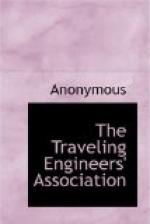130. Q. With the application valve in lap position, if there be brake cylinder leakage, will the locomotive brake leak off?
A. No; any drop in brake cylinder pressure will be felt in chamber “b” at the right of the application piston 10, causing a difference in pressure on the two sides of the piston, thus allowing the pressure in the application cylinder to move the application piston and valve to the right, again opening the supply port “b” allowing a further flow of main reservoir air from chamber “a” to the brake cylinders until the pressure is again slightly greater than that in the application cylinder “g”, when the application piston and valve will move back to lap position. Thus in this way air will be supplied to the brake cylinders of the locomotive, holding the brake applied regardless of leakage.
131. Q. What effect will piston travel have on the pressure developed in the brake cylinders?
A. None; as the pressure in the brake cylinders is entirely dependent on the pressure in the application cylinder, which is not affected by piston travel.
132. Q. Explain the movement of the parts in the distributing valve when the automatic brake valve is moved to release position, after an automatic application of the brake.
A. In release position of the brake valve, air from the main reservoir flows direct to the brake pipe, causing a rise of pressure which is felt in chamber “p” on the right or brake pipe side of the equalizing piston 26; this increase of pressure will cause the piston to move toward the left, carrying the graduating valve 28 and slide valve 31 to release position.
[Illustration: Fig. 10. Service Lap.]
This allows the air from the application chamber and cylinder to flow to the distributing valve release pipe “IV” and on through the independent brake valve to the automatic brake valve, where the port to which this pipe leads is blanked by the automatic rotary valve, thus preventing the air from leaving the application chamber and cylinder, holding the locomotive brake applied while the train brakes are being released. The movement of the parts, and the results obtained are the same where the release is made in holding position.
133. Q. Explain the movement of the parts in the distributing valve when the brake valve is moved to running position after having first been moved to release or holding position, following a brake application.
A. In this position of the brake valve the port to which the distributing valve release pipe is connected is open to the exhaust, thus allowing the air to escape from the application chamber and cylinder. The reduction of pressure in chamber “g”, will allow the brake cylinder pressure in chamber “b” to force the application piston and its valves to release position, thus allowing the brake cylinder air to escape to the atmosphere, through the exhaust ports “e” and “d”. (See Fig. 8.)




